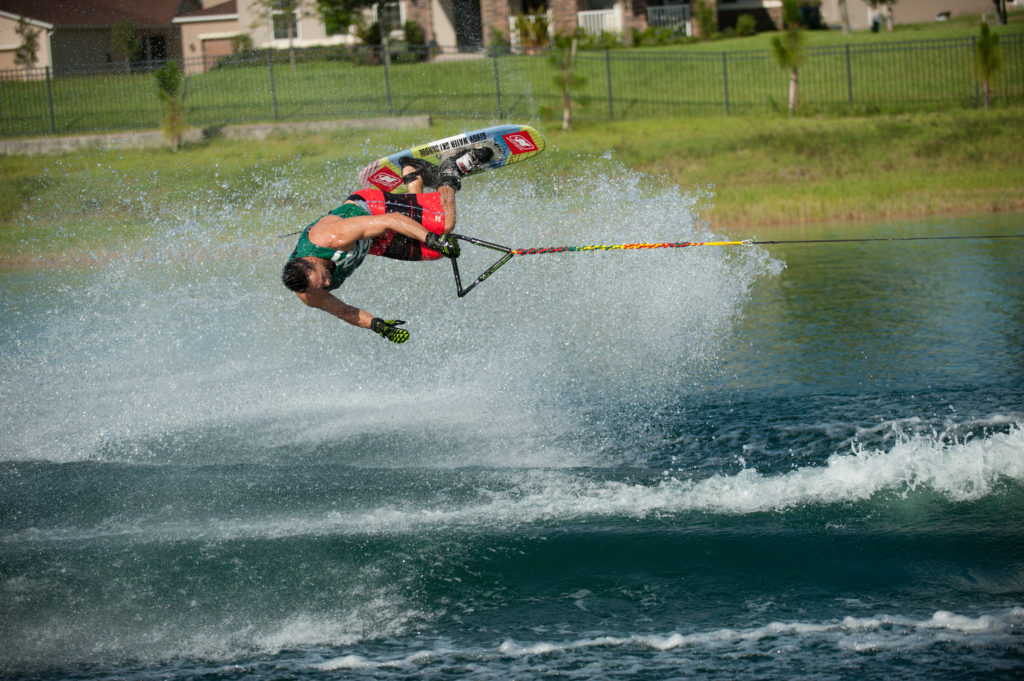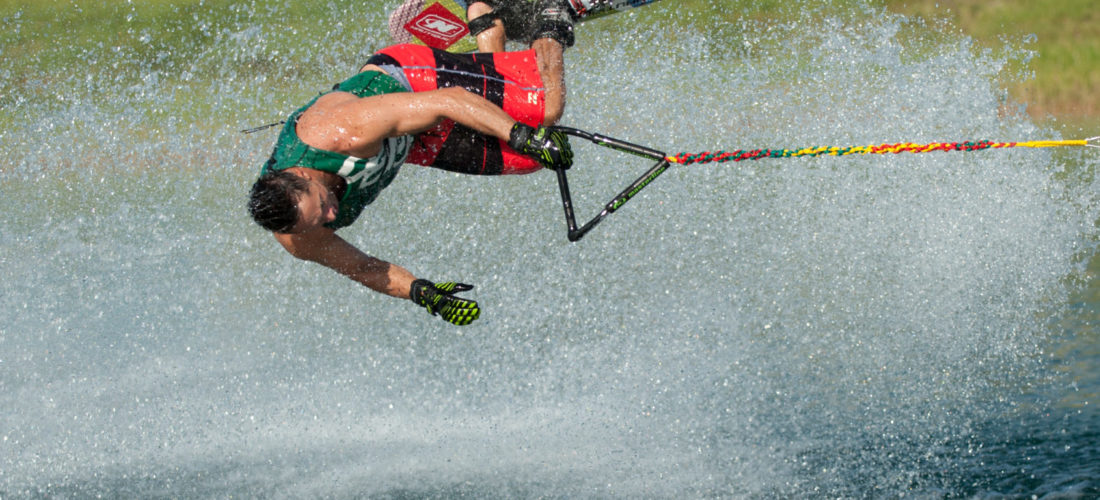Steeped in Tradition or Stuck in the Past? The Current State of Competitive Trick Skiing

Aliaksei Zharnasek (image: trickskiboss.com)
By Trent Finlayson
Waterski Magazine
April, 2014
With amateur participation numbers on decline and fewer elite events than ever, trick skiing appears to be on a downward slide. Opinion is based on vantage, however. Ask some of the athletes and coaches at the sport’s forefront, and you will get a slightly more optimistic view.
“I spend more than 500 hours a year coaching trick skiers,” says Matt Rini, former pro tricker and current coach of the Canadian National Team. “Based on what I see behind my boat every day, trick skiing is far from dead.” Famed ski and wakeboard coach Mike Ferraro echoes a similar sentiment. “The stuff these guys and girls are truly capable of is mind-blowing,” he says. “And they are only getting better.”
If the level of trick skiing is on the rise at both the amateur and pro levels, why are general participation numbers dwindling? Many industry leaders point to the sport’s resistance to change as its greatest limiting factor.
Ferraro has bean coaching trick skiing for more than 35 years, and while he has seen the sport excel in terms of on-water talent, he feels the event has unfortunately stalled. “Traditionally, the international rules committee has consisted of representatives that don’t fully understand the sport,” he says. “They are holding back the event, and as a result, the athletes are being stifled of their creativity. A reevaluation of the points would be a great place to start. Obviously, we need to drop the limit on the number of flips the skiers are allowed to do. If a specific invert is a recognized trick, it makes no sense to say a skier can’t include it in their run.”
Camillo Espinel, another coach of numerous world champions, feels the state of the event is in the eye of the beholder. “It really depends upon the collective goal of the governing bodies,” Espinel says. “If the goal is to make trick skiing more appealing to the masses, a change in format is necessary.” He believes the current format rewards conservatism and limits the athletes true abilities as skiers.
“Aliaksei Zharnasek won the Worlds with a run he can do blindfolded. The incentive model is askew with the current rule book; that forces our athletes to compete at about 70 percent of their true potential,” Espinel says. “It would be like a slalom event judged on who runs the best 38 off without ever advancing to 39 or 41 off.”
Zharnasek, a three-peat world trick champion and student of Espinel, says, “Trick skiing has been stuck at the same level for too long.” The 34-year-old Belarusian athlete isn’t calling for a vast restructure of the event, just a shift in thinking. “I would like to see a sliding scale within the point system that would give partial points for tricks that are not perfectly performed. I strongly believe that the current methodology of judging is holding the event back; it is pushing kids away from the sport.” Zharnasek says he would like to see the point system reward riskier runs. “Many skiers’ runs are nearly identical,” he says. “There are some extremely hard trick combinations that never get used because the risk trumps the reward.”
Eighteen-year-old women’s trick world-record holder and world champion Erika Lang agrees with Zharnasek. “I would like to see trick skiing become a more expressive sport for its athletes,” she says. “The current runs all look the same. If the six-flip limit was lifted, skiers would be free to construct any run they wanted. It would make it far more appealing to spectators.”
The stringent format of the event may have to stand aside for Lang, as she contemplates pursuing wakeboarding. “I have been riding a bit this winter, and my tricks are transferring over really well. I would like to keep at it and see how it goes.”
American senior official and American Water Ski Association Rules Committee member Kathy Ives is one official not afraid of changes as long as it doesn’t overly detract from trick skiing in it’s traditional form. “Some restructuring to the point system is in order to ensure the more difficult tricks are being rewarded properly,” she says. “Like any rule change in our sport; however, it takes time and eventual support from the international body, the [International Waterski & Wakeboard Federation].”
It’s a process Ives knows all too well. “When a trick is being considered, it must first pass through the different levels of the governing body.”
Starting with the national rules committee, the members review the trick, vote on its validity and pass their suggestions onto the national board of directors for approval. From there, the new trick must be accepted by the IWWF before officially being adopted. While Ives is in support of advancing the sport, she understands the importance of weighing each possible rule change carefully. “Generally speaking, they don’t want trick skiing to morph into wakeboarding,” she says. “They want to reinforce the discipline that is required to master all facets of the trick event, from inverts to ski lines to toes. Tricks is considered the gold standard of traditional three-event skiing, and many are afraid to lose that history moving forward.”
Rini knows the sport can advance without mirroring its wakeboarding brethren. “The fast-paced nature of the sport, as dictated by the 20-second time limit, is really what differentiates trick skiing from wakeboarding,” he says. “And that will never go away.”
To Rini, the answer is simple, and it’s one that does not risk the integrity of the sport. “There needs to be a reassignment of points that will allow skiers to structure their passes to suit their strengths,” he says. “If inverts are your strength, you should be able to put together a run with mostly flips. Or if it’s ski lines or toes or spins, you should be able to place your emphasis there. Even if the flip limit is opened up, the winner will still have to be the most well-rounded tricker.”
Sounds reasonable. But if our governing body’s historical resistance to change is any indication, improving the trick event is likely to be a long, slow process.
This article originally appeared in the April 2014 edition of Waterski Magazine.

